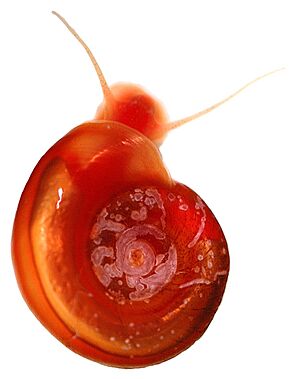Biomphalaria facts for kids
Quick facts for kids Biomphalaria |
|
|---|---|
 |
|
| An albino individual of Biomphalaria glabrata | |
| Scientific classification |
|
| Kingdom: | Animalia |
| Phylum: | Mollusca |
| Class: | Gastropoda |
| Subclass: | Heterobranchia |
| Clade: | Euthyneura |
| Superorder: | Hygrophila |
| Family: | Planorbidae |
| Subfamily: | Planorbinae |
| Tribe: | Helisomatini |
| Genus: | Biomphalaria Preston, 1910 |
| Type species | |
| Biomphalaria smithi Preston, 1910
|
|
| Diversity | |
| 34 species | |
| Synonyms | |
|
Taphius (H. Adams & A. Adams, 1855) Planorbis (Planorbina) (Haldeman, 1842) |
|
Biomphalaria is a group (called a genus) of freshwater snails. These snails breathe air and live in water. They belong to the family called Planorbidae, which are known as ram's horn snails. This name comes from their unique shell shape.
The shell of Biomphalaria snails coils to the left. This is called sinistral. However, the snail carries its shell upside down. This makes it look like the shell coils to the right, which is called dextral.
Contents
What are Biomphalaria Snails?
These snails are important in science. They are known to carry tiny living things called parasites. These parasites can cause a serious illness in humans. Because of this, scientists study Biomphalaria snails a lot.
Different Kinds of Biomphalaria Snails
Scientists believe there are about 35 different kinds (or species) of Biomphalaria snails alive today. About 21 of these species live in the New World (like South America). The other 14 species live in the Old World (like Africa and the Middle East).
It can be tricky to tell the different species apart. Sometimes, snails of the same species can look very different. This is because their environment can change how their shells grow.
Snails from the Americas
Here are some of the Biomphalaria species found in the Americas:
- Biomphalaria amazonica
- Biomphalaria andecola
- Biomphalaria cousini
- Biomphalaria edisoni
- Biomphalaria glabrata
- Biomphalaria havanensis
- Biomphalaria helophila
- Biomphalaria intermedia
- Biomphalaria kuhniana
- Biomphalaria obstructa
- Biomphalaria occidentalis
- Biomphalaria oligoza
- Biomphalaria orbignyi
- Biomphalaria peregrina
- Biomphalaria prona
- Biomphalaria schrammi
- Biomphalaria straminea
- Biomphalaria subprona
- Biomphalaria temascalensis
- Biomphalaria tenagophila
Snails from Africa and the Middle East
These are some of the Biomphalaria species found in Africa, Madagascar, and the Middle East. Scientists use special tests (like DNA tests) to confirm these species:
- Biomphalaria alexandrina
- Biomphalaria angulosa
- Biomphalaria camerunensis
- Biomphalaria choanomphala
- Biomphalaria pfeifferi
- Biomphalaria smithi (This is the main species that represents the whole Biomphalaria group.)
- Biomphalaria stanleyi
- Biomphalaria sudanica
There is also a known hybrid snail. This is a mix of two different species: Biomphalaria glabrata × Biomphalaria alexandrina.
Some other species are suspected to exist based on how they look:
- Biomphalaria arabica
- Biomphalaria barthi
- Biomphalaria rhodesiensis
- Biomphalaria ruppellii
- Biomphalaria salinarum
- Biomphalaria tchadiensis
How Biomphalaria Snails are Related
Scientists use DNA to figure out how different species are related. They have created a family tree (called a cladogram) for Biomphalaria snails. This tree shows that the Biomphalaria genus likely started in the Americas a very long time ago, about 60 million years ago.
Later, one type of Biomphalaria snail, Biomphalaria glabrata, traveled from the Americas to Africa. This happened between 2 to 5 million years ago. Once in Africa, this snail changed and developed into all the different African Biomphalaria species we see today.
Where Biomphalaria Snails Live
Biomphalaria snails naturally live in tropical and subtropical areas. You can find them in still water or freshwater in South America and Africa. They can even survive for a long time out of water.
Four species of Biomphalaria snails have spread beyond their original homes: Biomphalaria glabrata, Biomphalaria pfeifferi, Biomphalaria straminea, and Biomphalaria tenagophila. They have been found in new places like Congo, Egypt, Texas, Louisiana, Florida, and Hong Kong.
In the United States, most Biomphalaria species are not native. They are seen as a potential problem. This is because they could harm farming, natural environments, or even human health if they spread widely. Because of this, there are strict rules to prevent them from entering the country.
Snails and Health
Biomphalaria snails are very important in health studies. This is because they can carry a tiny parasite called Schistosoma mansoni. This parasite causes a disease in humans called schistosomiasis, also known as snail fever.
About 83 million people are affected by this parasite. The disease is common in tropical areas. Here's how it works:
- The snails release tiny parasite larvae (called cercariae) into the water.
- If people come into contact with this water, the larvae can enter their skin.
- Once inside the body, the larvae grow into adult parasites.
Many Biomphalaria species can carry this parasite. Scientists have tested 18 species and found they can be infected. Some species are resistant, meaning they cannot carry the parasite. There are also many other types of parasites that can live in Biomphalaria snails.



